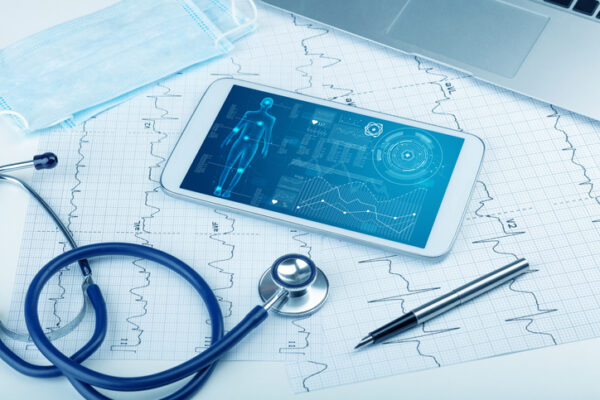
Medical full body screening software on tablet and healthcare devices
Many patients in critical care at hospitals are hooked up to monitors or ventilators that automatically collect a continuous stream of data. Data from these integrated medical devices are pulled into a platform that gives doctors, nurses and care teams insights for making decisions about their patients, automates their documentation, and manages device alarms, among other things.
These integrated devices not only reduce clinician workload, but they also eliminate delays and human mistakes in data entry, both of which can impact treatment.
Most significantly, the data collected by integrated medical devices provides clinicians with a complete and accurate patient record from connected documentation and clinical information systems. This provides evidence-based support for their decisions and strong interdisciplinary communication to facilitate care coordination.
Given the obvious benefits of integrated monitors and ventilators, it’s clear that the integration of other devices – both within and outside critical care units – by healthcare organizations would boost clinical and operational performance while improving patient safety and care coordination.
The vast majority of nurses in an industry survey see the benefits of integrating devices: 93% strongly agreed that medical devices should be able to seamlessly share data automatically. Nearly three in four (74%) nurses strongly agreed that it is a burden to coordinate data collected by medical devices, while 91% said they would spend more hands-on time with their patients if they could spend less time dealing with devices.
Below are some medical devices beyond monitors and ventilators that hospitals and health systems can integrate to benefit clinicians, patients, and operations.

Reducing Clinical and Staff Burnout with AI Automation
As technology advances, AI-powered tools will increasingly reduce the administrative burdens on healthcare providers.
Dialysis machines
Outside of the ICU or similar environments, hemodialysis data often is manually recorded and later entered into an electronic health record (EHR) and other downstream systems. This process frequently results in incomplete or inaccurate records, which can be a potential danger because patients receiving hemodialysis typically have multiple comorbidities such as diabetes, hypertension, and liver disease. Automatically capturing the data creates comprehensive and accurate documentation that better supports care decisions and allows clinicians to spend more time with patients.
Cardiopulmonary devices
Cardiopulmonary bypass machines, which take over the functions of a person’s heart and lungs during surgery, are commonly used in hospital operating rooms. Yet these devices typically aren’t integrated into clinical IT systems. While the patient’s vital signs are constantly being monitored during the surgery, the perfusionist is left to communicate machine-captured data to the operating room team verbally and through handwritten notes. This not only is inefficient, but also introduces the potential for human error.
If a cardiopulmonary bypass machine is connected to an integrated medical platform, however, interdisciplinary care team members, such as the anesthesiology team, can view the latest data without an intermediary or delay.
Other integrated medical devices, such as intra-aortic balloon pumps, end-tidal CO2 or pulse oximeter devices, can be used by clinicians, post-surgery, to monitor a patient’s recovery and to help complete documentation to improve care coordination.
Decreasing ‘Alert Fatigue’
Clinicians may get as many as 1,000 patient safety alerts per shift. This can lead to a phenomenon known as “alert fatigue,” where busy clinicians become desensitized to safety alerts. The Agency for Healthcare Research and Quality (AHRQ) says alert fatigue “is now recognized as a major unintended consequence of the computerization of healthcare and a significant patient safety hazard.” AHRQ cites a 2011 Boston Globe investigation that “identified more than 200 deaths over a 5-year period attributable to failure to appropriately heed alarms from physiologic monitoring systems.”
Connecting disparate medical devices and locating the collected data in a central location where it can be analyzed and contextualized enables providers to reduce the number of “nuisance” alerts and the impact of alert fatigue. The result will be higher clinician preparedness and a more effective response.
Medical alerts are intended to make clinicians immediately aware of potentially abnormal vital signs in a patient. By continuously monitoring numerous physiologic parameters with more intelligent alerts, clinicians can respond before an adverse event occurs. An international study of 7,851 cardiac patients published in 2016 found that 59.4% had at least one abnormal vital sign one to four hours before cardiac arrest, and 13.4% had at least one severely abnormal vital sign.
Broader device data integration into a clinical surveillance system can help clinicians intervene before an adverse event. A nearly two-year study of one such system for monitoring post-surgical patients in a non-critical orthopedic unit in New Hampshire showed a sharp reduction in “rescue events” to 1.2 events from 3.4 events per 1,000 patient discharges, while ICU transfers were cut to 2.9 per 1,000 patient days from 5.6.
This study and a growing body of clinical research show that effective data management drives operational, clinical and patient outcome success, whether under traditional or value-based care payment models. Providers must recognize that each data point from a medical device has intrinsic value if harnessed properly. The tools exist now to extract more value from medical device data for providers and patients.
Photo: ra2studio, Getty Images
Teresa Soman, MBA, PMP is director of product management at Capsule, a Philips company. She can be reached at [email protected].
This post appears through the MedCity Influencers program. Anyone can publish their perspective on business and innovation in healthcare on MedCity News through MedCity Influencers. Click here to find out how.










